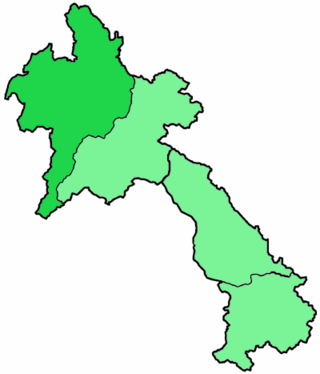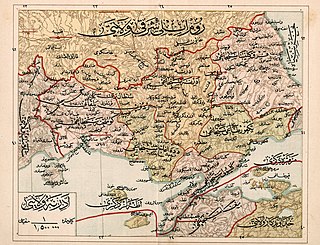
An exarch was the holder of any of various historical offices, some of them being political or military and others being ecclesiastical.

An apostolic vicariate is a territorial jurisdiction of the Catholic Church under a titular bishop centered in missionary regions and countries where dioceses or parishes have not yet been established. It is essentially provisional, though it may last for a century or more. The hope is that the region will generate sufficient numbers of Catholics for the Church to create a diocese. In turn, the status of apostolic vicariate is often a promotion for a former apostolic prefecture, while either may have started out as a mission sui iuris.

The Apostolic Vicariate of Pakse is a Latin rite missionary territorial jurisdiction of the Catholic Church in Laos. As an apostolic vicariate, it is a pre-diocesan jurisdiction, entitled to a titular bishop. It covers southern Laos.

The Apostolic Vicariate of Luang Prabang is a Latin rite jurisdiction of the Catholic Church in Laos. As an apostolic vicariate, it is a pre-diocesan jurisdiction, entitled to a titular bishop. It is located in northern Laos.

The Catholic Church in North Macedonia is part of the worldwide Catholic Church, under the spiritual leadership of the Pope in Rome and is one of the major religious communities that exist on the territory of the Republic of North Macedonia. Catholic believers from North Macedonia mostly include Albanians, Macedonians and Croats and are most concentrated in the Skopje Statistical Region and the Southeastern Statistical Region of North Macedonia. There are around 20,000 Catholics in the country — around 1% of the total population.

The Bulgarian Greek Catholic Church, sometimes called, in reference to its Byzantine Rite, the Bulgarian Byzantine Catholic Church is a sui juris particular church in full communion with the Catholic Church and the Pope of Rome. Its adherents are called often Uniates.
The Apostolic Vicariate of Gambella is a Catholic missionary pre-diocesan jurisdiction in the western part of Ethiopia.

The Apostolic Vicariate of Thessaloniki is a Latin Church ecclesiastical territory or apostolic vicariate of the Catholic Church in northern continental Greece.

The Eparchy of Križevci is a Greek Catholic Church of Croatia and Serbia eparchy of the Catholic Church in Croatia, Slovenia, and Bosnia and Herzegovina. Its current eparch is Milan Stipić. The cathedra is in the Cathedral of the Holy Trinity, in the episcopal see of Križevci, Croatia.
The Apostolic Vicariate of Rundu is a Roman Catholic apostolic vicariate in Namibia. Its cathedral episcopal see is St. Mary's in the city of Rundu.

Raphael Popov was a Bulgarian Byzantine-Catholic bishop and one of the leaders of Bulgarian national revival. Originally he was an Eastern Orthodox deacon, but converted in 1860 to Catholic Church. In 1865, he became Administrator of the Bulgarian Byzantine Catholic Church in the Ottoman Empire and was ordained as bishop.
The Apostolic Vicariate of Pucallpa is a Latin Church Apostolic vicariate of the Catholic Church in Peru. It is immediately exempt to the Holy See and not part of any ecclesiastical province.

The Vicariate Apostolic of Mitú is a Latin pre-diocesan jurisdiction of the Catholic Church in Colombia.
The Apostolic Vicariate of Beirut is a Latin Church ecclesiastical jurisdiction or apostolic vicariate of the Catholic Church in Lebanon, where Eastern Catholics are far more numerous. In 2010, there were 15,000 baptized. Its current bishop is Cesar Essayan.

The Apostolic Vicariate of Bontoc-Lagawe is a Latin Church missionary ecclesiastical jurisdiction or apostolic vicariate of the Catholic Church in the Philippines.
The Greek Catholic Apostolic Exarchate of Istanbul (or of Constantinople) (Exarchatus Apostolicus Constantinopolitanus) is the senior of two missionary pre-diocesan Eastern Catholic jurisdictions that constitute the Greek Byzantine Catholic Church, an Eastern Catholic Church of the Byzantine Rite in the Greek language.

The Bulgarian Eparchy of Saint John XXIII of Sofia is the fourth, so far last and sole jurisdiction, covering Bulgaria, of the Bulgarian Greek Catholic Church.

The Bulgarian Catholic Apostolic Vicariate of Constantinople was the first missionary, pre-diocesan jurisdiction of the Bulgarian Greek Catholic Church sui iuris. As Apostolic Vicariate it was exempt, i.e. directly dependent on the Holy See, and entitled to a titular bishop. It was created in 1861 and reorganized in 1883.

The Bulgarian Catholic Apostolic Vicariate of Tracia was the second missionary, pre-diocesan jurisdiction of the Bulgarian Greek Catholic Church sui iuris.















